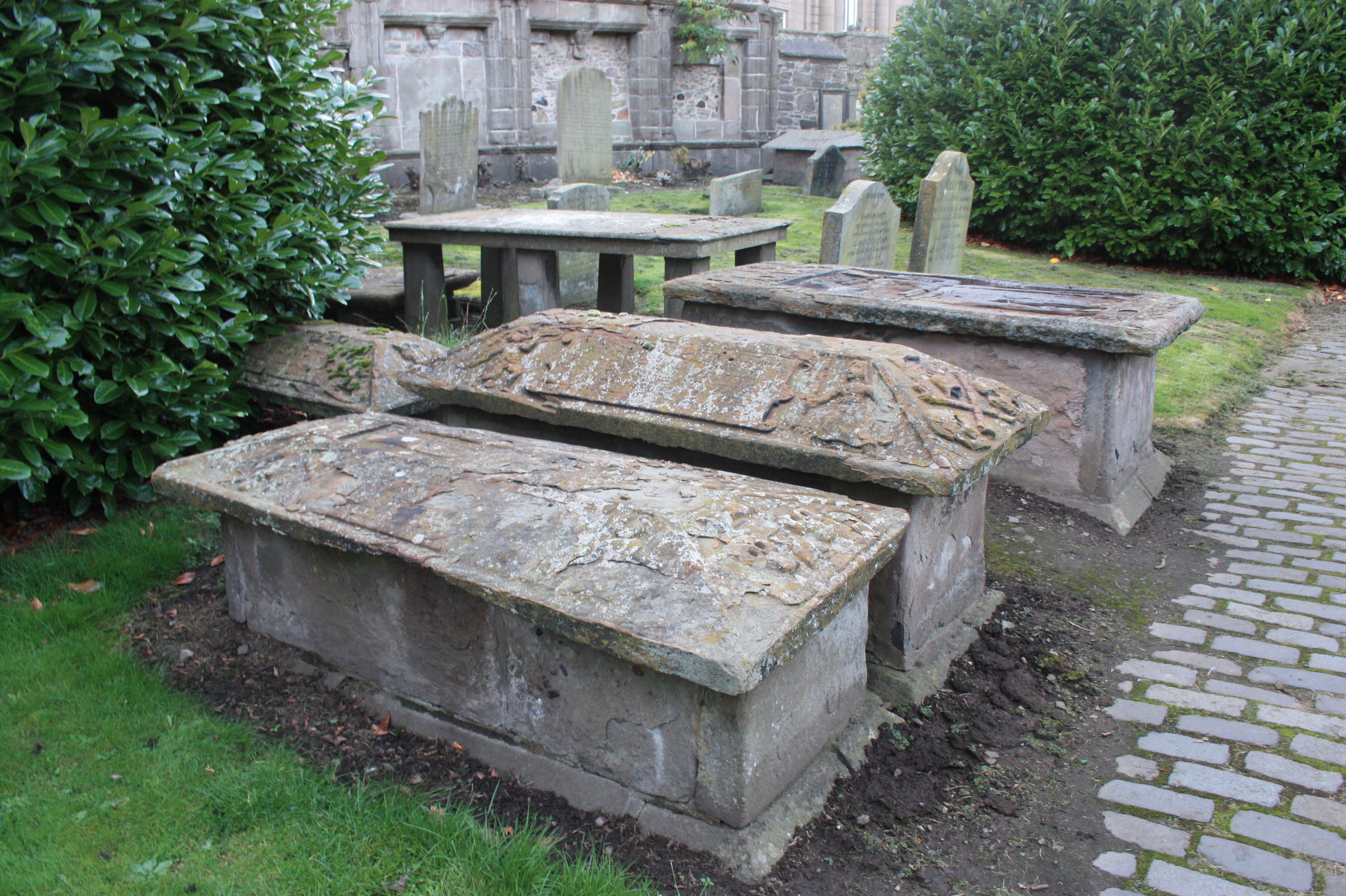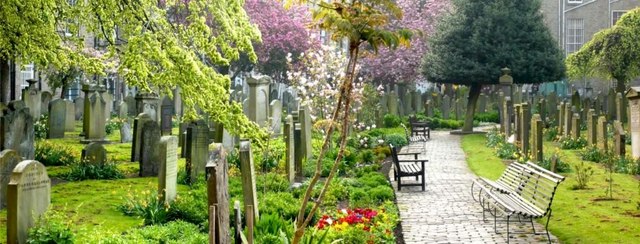The Howff on:
[Wikipedia]
[Google]
[Amazon]


 The Howff is a burial ground in the city of Dundee,
The Howff is a burial ground in the city of Dundee,
 The land of the burial ground was part of the
The land of the burial ground was part of the
 Burials at The Howff include:
* Alexander Bell (1776–1852), surgeon
* Samuel Bell (1739-1813) town architect
* Thomas Bell (1759–1844), Provost of Dundee
* James Chalmers (1782–1853), printer, bookseller and inventor of the adhesive postage stamp
* Sir Alexander Douglas of Glenbervie (1738–1812)
* George Duncan (1791–1878), politician and last person to be buried in the Howff
* George Forrester (1635–1675), Dean of Guild in Dundee
* John Glas (1695–1773), clergyman and founder of the
Burials at The Howff include:
* Alexander Bell (1776–1852), surgeon
* Samuel Bell (1739-1813) town architect
* Thomas Bell (1759–1844), Provost of Dundee
* James Chalmers (1782–1853), printer, bookseller and inventor of the adhesive postage stamp
* Sir Alexander Douglas of Glenbervie (1738–1812)
* George Duncan (1791–1878), politician and last person to be buried in the Howff
* George Forrester (1635–1675), Dean of Guild in Dundee
* John Glas (1695–1773), clergyman and founder of the James Balfour Paul, ''Scots Peerage'', vol iii, p. 17. Edinburgh 1904
Archive.org
* John Lyon (1765–1814), botanist (memorial only)
* John Pitcairn (d.1800), Provost of Dundee
* Alexander Riddoch (1744–1822), eight times Provost of Dundee
* John Scrymsour (sic) (1611–1657), Provost of Dundee
* The Wedderburn and
Tombs of the Dundee Howff
The Howff site record
at Canmore, Historic Environment Scotland * {{DEFAULTSORT:Howff
Cemeteries in Scotland
Category A listed buildings in Dundee
1564 establishments in Scotland
History of Dundee
{{DEFAULTSORT:Howff
Cemeteries in Scotland
Category A listed buildings in Dundee
1564 establishments in Scotland
History of Dundee


 The Howff is a burial ground in the city of Dundee,
The Howff is a burial ground in the city of Dundee, Scotland
Scotland (, ) is a Countries of the United Kingdom, country that is part of the United Kingdom. Covering the northern third of the island of Great Britain, mainland Scotland has a Anglo-Scottish border, border with England to the southeast ...
. Established in 1564, it has one of the most important collections of tombstones in Scotland, and is protected as a category A listed building
Category, plural categories, may refer to:
Philosophy and general uses
*Categorization, categories in cognitive science, information science and generally
*Category of being
* ''Categories'' (Aristotle)
*Category (Kant)
* Categories (Peirce)
* ...
.
The majority of graves face exactly due east.
History
 The land of the burial ground was part of the
The land of the burial ground was part of the Franciscan
, image = FrancescoCoA PioM.svg
, image_size = 200px
, caption = A cross, Christ's arm and Saint Francis's arm, a universal symbol of the Franciscans
, abbreviation = OFM
, predecessor =
, ...
(Greyfriars) Monastery until the Scottish Reformation
The Scottish Reformation was the process by which Scotland broke with the Papacy and developed a predominantly Calvinist national Kirk (church), which was strongly Presbyterian in its outlook. It was part of the wider European Protestant Refor ...
. In 1564 Mary, Queen of Scots
Mary, Queen of Scots (8 December 1542 – 8 February 1587), also known as Mary Stuart or Mary I of Scotland, was Queen of Scotland from 14 December 1542 until her forced abdication in 1567.
The only surviving legitimate child of James V of S ...
granted the land to the burgh of Dundee, for use as a burial ground. It was used for meetings by the Dundee Incorporated Trades, and subsequently became known as The Howff, from the Scots word '' howff'' 'an enclosed open space, yard, area (as a timber yard)', likely related to German or Dutch ''hof'' 'enclosed space, courtyard'. Old parish records for burials within The Howff begin in the late 18th century. Prior to this records of mortcloth hire, a cloth rented out by the Guildry and Trades to cover bodies or coffins before burial, provide evidence of burials dating back to 1655. Meetings at The Howff ceased in 1776. The last burial took place in 1878 (George Duncan). The walls along the west side date from 1601.
The vault to the extreme south west (now simply saying "Blackness" inside) was the burial Vault of the Wedderburns of Blackness House in Dundee. A sealed window on its exterior appears to indicate this was either a watch-house or part of the original meeting-house prior to the vault being built (c.1630).
The graveyard is highly unusual by Scottish standards, containing a high number of Roman-style coffer tombs. It also contains a high number of inscriptions which philosophise on death itself rather than discussing the person interred.
Of the 80,000 burials in the Howff around 3% are classed as "foreign" but with many simply bearing this label due to birth at sea, reflecting Dundee's maritime heritage. As an odder distinction, some 10% of the deaths are specifically recorded as "Irish burials", largely labourers in the early 19th century.
Burials
 Burials at The Howff include:
* Alexander Bell (1776–1852), surgeon
* Samuel Bell (1739-1813) town architect
* Thomas Bell (1759–1844), Provost of Dundee
* James Chalmers (1782–1853), printer, bookseller and inventor of the adhesive postage stamp
* Sir Alexander Douglas of Glenbervie (1738–1812)
* George Duncan (1791–1878), politician and last person to be buried in the Howff
* George Forrester (1635–1675), Dean of Guild in Dundee
* John Glas (1695–1773), clergyman and founder of the
Burials at The Howff include:
* Alexander Bell (1776–1852), surgeon
* Samuel Bell (1739-1813) town architect
* Thomas Bell (1759–1844), Provost of Dundee
* James Chalmers (1782–1853), printer, bookseller and inventor of the adhesive postage stamp
* Sir Alexander Douglas of Glenbervie (1738–1812)
* George Duncan (1791–1878), politician and last person to be buried in the Howff
* George Forrester (1635–1675), Dean of Guild in Dundee
* John Glas (1695–1773), clergyman and founder of the Glasite
The Glasites or Glassites were a small Christian church founded in about 1730 in Scotland by John Glas.John Glas preached supremacy of God's word (Bible) over allegiance to Church and state to his congregation in Tealing near Dundee in July 172 ...
movement
* Clementina Stirling Graham (1782–1877), Scottish hostess and author
* James and Janet Keiller (1737–1813), creators of Keiller's marmalade
* Baron Jhone Kynnier (John Kinnear) (1511–1584)
* David Lindsay, 1st Earl of Crawford
David Lindsay, 1st Earl of Crawford (c. 13601407) was a Scottish peer who was created Earl of Crawford in 1398.
Life
Crawford was the son of Sir Alexander Lindsay of Glenesk and Katherine Stirling. Succeeding his father in 1381, he was known u ...
(c.1360–1407), interred in the now destroyed pre-reformation Greyfriars kirkArchive.org
Ogilvy-Wedderburn baronets
The Wedderburn, later Ogilvy-Wedderburn Baronetcy, of Balindean in the County of Perth, is a title in the Baronetage of the United Kingdom created in 1803.
Balindean
The place-name associated with the baronetcy is Balindean; the place itself is ...
of Balindean (multiple graves)
The New Howff
In 1834 a new cemetery, which was known as the New Howff, was opened on what was then the northern edge of the town on the lower slopes ofDundee Law
Dundee Law is a hill in the centre of Dundee, Scotland, and is the highest point in the city. The Law is what remains of a volcanic sill, which is the result of volcanic activity around 400 million years ago. With a large war memorial at its su ...
. This cemetery, which was influenced by Glasgow Necropolis
The Glasgow Necropolis is a Victorian cemetery in Glasgow, Scotland. It is on a low but very prominent hill to the east of Glasgow Cathedral (St. Mungo's Cathedral). Fifty thousand individuals have been buried here. Typical for the period, only ...
, was more or less destroyed by later building works. Firstly the construction of Dundee's inner ring road in the 1960s cut through the site, and this was followed by the erection of a multi-storey car park over the New Hoff's southern end. Some grave stones were saved and positioned against its western wall which had originally been the boundary between the cemetery and the Dundee and Newtyle Railway
The Dundee and Newtyle Railway opened in 1831 and was the first railway in the north of Scotland. It was built to carry goods between Dundee and the fertile area known as Strathmore; this involved crossing the Sidlaw Hills, and was accomplish ...
.
References
External links
Tombs of the Dundee Howff
The Howff site record
at Canmore, Historic Environment Scotland *
 {{DEFAULTSORT:Howff
Cemeteries in Scotland
Category A listed buildings in Dundee
1564 establishments in Scotland
History of Dundee
{{DEFAULTSORT:Howff
Cemeteries in Scotland
Category A listed buildings in Dundee
1564 establishments in Scotland
History of Dundee